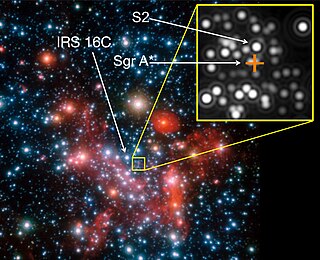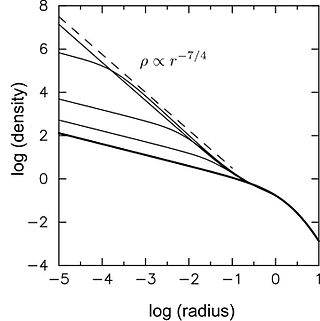David Merritt | |
|---|---|
 David Merritt |
David Roy Merritt (born November 16, 1955, in Los Angeles) is an American astrophysicist.
David Merritt | |
|---|---|
 David Merritt |
David Roy Merritt (born November 16, 1955, in Los Angeles) is an American astrophysicist.
He received in 1982 his PhD in Astrophysical Sciences from Princeton University with thesis advisor Jeremiah P. Ostriker [1] and held postdoctoral positions at the University of California, Berkeley and the Canadian Institute for Theoretical Astrophysics in Toronto. Merritt's fields of specialization include dynamics and evolution of galaxies, supermassive black holes, and computational astrophysics.
Until 2017, he was a professor at the Rochester Institute of Technology (RIT) in Rochester, New York. He was a former Chair of the Division on Dynamical Astronomy of the American Astronomical Society. He is a founding member of the Center for Computational Relativity and Gravitation at RIT.
His scientific contributions include Osipkov–Merritt models, [2] black hole spin flips, [3] the Leonard–Merritt mass estimator, [4] the M–sigma relation, [5] stellar systems with negative temperatures, [6] and the Schwarzschild Barrier. [7]
According to ScholarGPS, David Merritt is placed among the top 0.05% of all scholars worldwide based on his prolific publication record and the high impact of his work.

A black hole is a region of spacetime where gravity is so strong that nothing, including light and other electromagnetic waves, is capable of possessing enough energy to escape it. Einstein's theory of general relativity predicts that a sufficiently compact mass can deform spacetime to form a black hole. The boundary of no escape is called the event horizon. A black hole has a great effect on the fate and circumstances of an object crossing it, but it has no locally detectable features according to general relativity. In many ways, a black hole acts like an ideal black body, as it reflects no light. Quantum field theory in curved spacetime predicts that event horizons emit Hawking radiation, with the same spectrum as a black body of a temperature inversely proportional to its mass. This temperature is of the order of billionths of a kelvin for stellar black holes, making it essentially impossible to observe directly.
The Schwarzschild radius or the gravitational radius is a physical parameter in the Schwarzschild solution to Einstein's field equations that corresponds to the radius defining the event horizon of a Schwarzschild black hole. It is a characteristic radius associated with any quantity of mass. The Schwarzschild radius was named after the German astronomer Karl Schwarzschild, who calculated this exact solution for the theory of general relativity in 1916.

The Virgo Cluster is a large cluster of galaxies whose center is 53.8 ± 0.3 Mly away in the constellation Virgo. Comprising approximately 1,300 member galaxies, the cluster forms the heart of the larger Virgo Supercluster, of which the Local Group is a member. The Local Group actually experiences the mass of the Virgo Supercluster as the Virgocentric flow. It is estimated that the Virgo Cluster's mass is 1.2×1015M☉ out to 8 degrees of the cluster's center or a radius of about 2.2 Mpc.

A supermassive black hole is the largest type of black hole, with its mass being on the order of millions to billions times the mass of the Sun (M☉). Black holes are a class of astronomical objects that have undergone gravitational collapse, leaving behind spheroidal regions of space from which nothing can escape, including light. Observational evidence indicates that almost every large galaxy has a supermassive black hole at its center. For example, the Milky Way galaxy has a supermassive black hole at its center, corresponding to the radio source Sagittarius A*. Accretion of interstellar gas onto supermassive black holes is the process responsible for powering active galactic nuclei (AGNs) and quasars.

In astronomy, a galactic bulge is a tightly packed group of stars within a larger star formation. The term almost exclusively refers to the central group of stars found in most spiral galaxies. Bulges were historically thought to be elliptical galaxies that happened to have a disk of stars around them, but high-resolution images using the Hubble Space Telescope have revealed that many bulges lie at the heart of a spiral galaxy. It is now thought that there are at least two types of bulges: bulges that are like ellipticals and bulges that are like spiral galaxies.

An intermediate-mass black hole (IMBH) is a class of black hole with mass in the range 102–105 solar masses: significantly more than stellar black holes but less than the 105–109 solar mass supermassive black holes. Several IMBH candidate objects have been discovered in the Milky Way galaxy and others nearby, based on indirect gas cloud velocity and accretion disk spectra observations of various evidentiary strength.

A mass deficit is the amount of mass that has been removed from the center of a galaxy, presumably by the action of a binary supermassive black hole.

NGC 4395 is a nearby low surface brightness spiral galaxy located about 14 million light-years from Earth in the constellation Canes Venatici. The nucleus of NGC 4395 is active and the galaxy is classified as a Seyfert Type I known for its very low-mass supermassive black hole. It is one of the lowest

OJ 287 is a BL Lac object 5 billion light-years from Earth that has produced quasi-periodic optical outbursts going back approximately 120 years, as first apparent on photographic plates from 1891. Seen on photographic plates since at least 1887, it was first detected at radio wavelengths during the course of the Ohio Sky Survey. It is a supermassive black hole binary (SMBHB). The intrinsic brightness of the flashes corresponds to over a trillion times the Sun's luminosity, greater than the entire Milky Way galaxy's light output.
The sphere of influence is a region around a supermassive black hole in which the gravitational potential of the black hole dominates the gravitational potential of the host galaxy. The radius of the sphere of influence is called the "(gravitational) influence radius".

The M–sigmarelation is an empirical correlation between the stellar velocity dispersion σ of a galaxy bulge and the mass M of the supermassive black hole at its center.
The Sołtan argument is an astrophysical theory outlined in 1982 by Polish astronomer Andrzej Sołtan. It maintains that if quasars were powered by accretion onto a supermassive black hole, then such supermassive black holes must exist in our local universe as "dead" quasars.

The Sérsic profile is a mathematical function that describes how the intensity of a galaxy varies with distance from its center. It is a generalization of de Vaucouleurs' law. José Luis Sérsic first published his law in 1963.

S2, also known as S0–2, is a star in the star cluster close to the supermassive black hole Sagittarius A* (Sgr A*), orbiting it with a period of 16.0518 years, a semi-major axis of about 970 au, and a pericenter distance of 17 light hours – an orbit with a period only about 30% longer than that of Jupiter around the Sun, but coming no closer than about four times the distance of Neptune from the Sun. The mass when the star first formed is estimated by the European Southern Observatory (ESO) to have been approximately 14 M☉. Based on its spectral type, it probably has a mass of 10 to 15 solar masses.
A hypercompact stellar system (HCSS) is a dense cluster of stars around a supermassive black hole that has been ejected from the center of its host galaxy. Stars that are close to the black hole at the time of the ejection will remain bound to the black hole after it leaves the galaxy, forming the HCSS.

A binary black hole (BBH), or black hole binary, is a system consisting of two black holes in close orbit around each other. Like black holes themselves, binary black holes are often divided into stellar binary black holes, formed either as remnants of high-mass binary star systems or by dynamic processes and mutual capture; and binary supermassive black holes, believed to be a result of galactic mergers.

In astrophysics, an extreme mass ratio inspiral (EMRI) is the orbit of a relatively light object around a much heavier object, that gradually spirals in due to the emission of gravitational waves. Such systems are likely to be found in the centers of galaxies, where stellar mass compact objects, such as stellar black holes and neutron stars, may be found orbiting a supermassive black hole. In the case of a black hole in orbit around another black hole this is an extreme mass ratio binary black hole. The term EMRI is sometimes used as a shorthand to denote the emitted gravitational waveform as well as the orbit itself.

Bahcall–Wolf cusp refers to a particular distribution of stars around a massive black hole at the center of a galaxy or globular cluster. If the nucleus containing the black hole is sufficiently old, exchange of orbital energy between stars drives their distribution toward a characteristic form, such that the density of stars, ρ, varies with distance from the black hole, r, as

Laura Ferrarese is a researcher in space science at the National Research Council of Canada. Her primary work has been performed using data from the Hubble Space Telescope and the Canada-France-Hawaii Telescope.